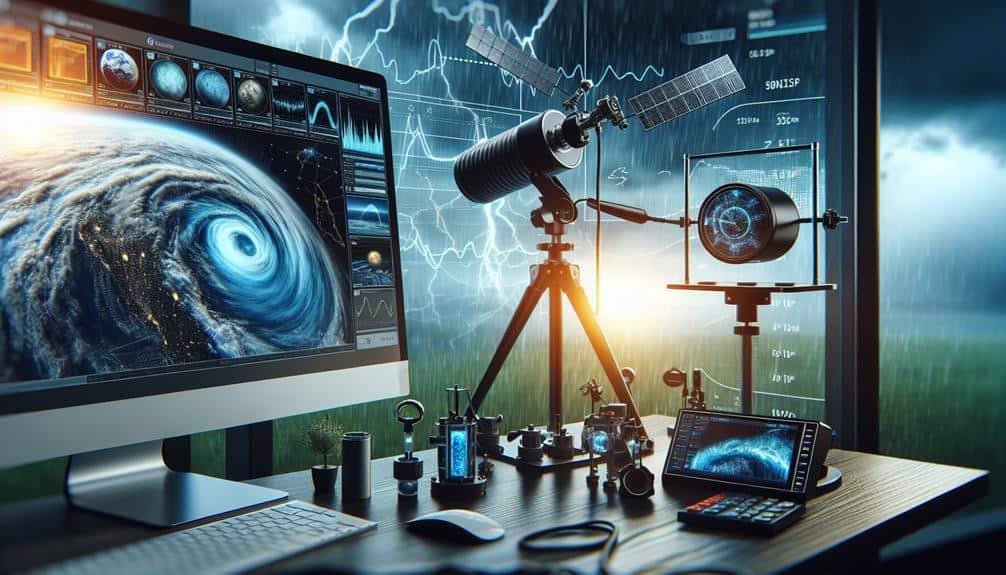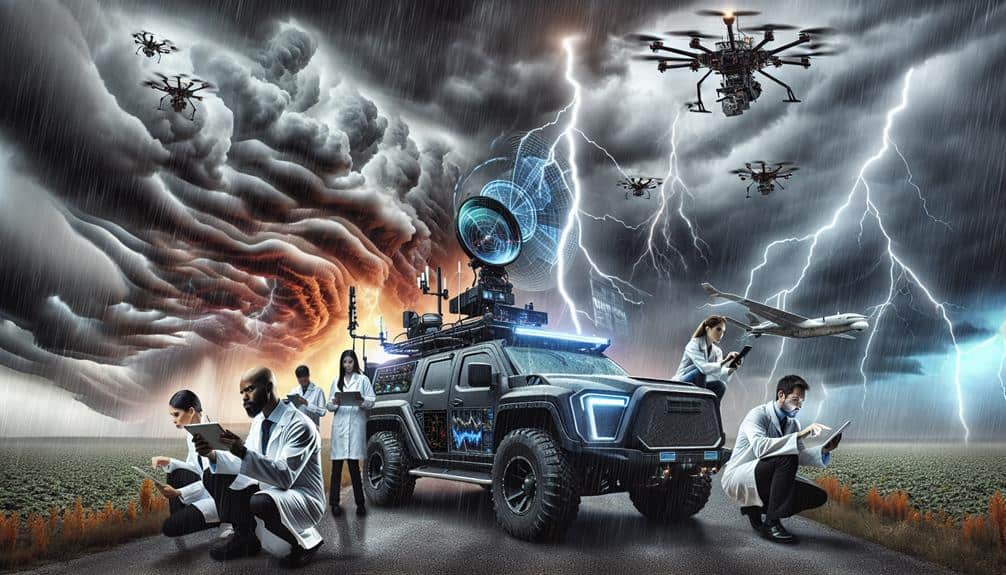Temperature variations impact storm prediction accuracy because they affect atmospheric pressure, humidity levels, and wind patterns. Small changes in temperature can alter atmospheric stability and trigger convection currents essential for storm development. For instance, a 1°C rise increases atmospheric moisture by about 7%, fueling storm intensity. Sharp temperature gradients drive high wind shear and updraft zones, which are critical for storm formation. Errors in capturing these gradients and temperature anomalies, such as inversions, complicate forecasting. Advances in remote sensing and satellite technology have improved data accuracy, but challenges remain. Understanding these dynamics is key to improving our forecasts.
Key Points
- Temperature anomalies disrupt atmospheric stability, triggering convection currents critical for storm development.
- Sharp temperature gradients drive atmospheric instability, leading to challenges in accurately predicting storm formation and intensity.
- Temperature inversions distort atmospheric readings and hinder upward air movement, complicating storm prediction.
- Surface temperature fluctuations directly influence storm likelihood and intensity by creating discrepancies in air density and pressure.
Role of Temperature in Storm Formation
Temperature plays a critical role in storm formation by influencing atmospheric pressure, humidity levels, and wind patterns. When we examine the atmospheric conditions, we see that temperature influences the behavior of air masses. Warmer air can hold more moisture, leading to higher humidity levels, which are essential for storm development.
Temperature anomalies, such as sudden increases or decreases, disrupt the stability of the atmosphere. These anomalies can trigger convection currents, causing warm, moist air to rise and cool, dry air to sink. This vertical movement is a key factor in the formation of storms. For instance, a temperature rise of 1°C can increase atmospheric moisture by approximately 7%, escalating the potential for storm formation.
Moreover, the influence of temperature on wind patterns is significant. Differential heating of the Earth's surface generates varying pressure zones, propelling wind currents that can steer storm systems.
Temperature Gradients and Weather Models
Understanding how temperature variations impact storm formation leads us to examine the role temperature gradients play in enhancing the accuracy of weather models.
When we analyze atmospheric dynamics, we see that temperature fluctuations directly influence the development and intensity of storms. Sharp temperature gradients, areas where temperature changes rapidly over a short distance, are critical in driving atmospheric instability and convection.
These gradients create zones of high wind shear and updraft, which are essential ingredients for storm formation. Weather models must accurately capture these gradients to predict storm behavior effectively.
However, forecasting challenges arise due to the complex nature of temperature gradients. Small errors in temperature data can lead to significant inaccuracies in model outputs, compromising our predictions.
Impact of Surface Temperatures
Surface temperatures play a pivotal role in storm formation and intensity, directly influencing the atmospheric conditions that weather models must accurately represent. When we observe temperature anomalies at the surface, they create discrepancies in air density and pressure, leading to significant variations in storm development. These anomalies can either amplify or mitigate the energy available for storms, thereby affecting forecasting accuracy.
For instance, warmer surface temperatures can enhance convection currents, increasing the potential for severe weather events. Conversely, cooler temperatures might suppress such activities. By closely monitoring these temperature fluctuations, we can better predict the likelihood and intensity of storms, though the local impacts remain complex.
Weather models integrate surface temperature data to simulate atmospheric dynamics accurately. However, even minor errors in these measurements can propagate through the model, leading to substantial deviations in storm forecasts. The local impacts of temperature fluctuations are especially critical in coastal regions where land and sea temperature contrasts are pronounced.
Thus, our ability to forecast storms hinges on precise surface temperature data. By improving our understanding of these temperature anomalies, we enhance our predictive capabilities, granting us the freedom to better prepare for impending weather events.
Temperature Inversions and Prediction Errors
When a temperature inversion occurs, it can distort atmospheric readings to a large extent, leading to increased prediction errors in storm forecasts. During a temperature inversion, the normal vertical temperature gradient is reversed, creating a warmer layer of air above a cooler layer. This unusual configuration affects atmospheric stability, making the lower atmosphere more stable and less likely to support the upward movement of air masses essential for storm development.
We face significant forecasting challenges under these conditions. Temperature anomalies introduced by inversions can mask critical signals in weather models, leading to inaccurate predictions. For instance, inversions can prevent the mixing of air layers, which makes it harder to detect developing storm systems using conventional radar and satellite data.
Additionally, the stability of the atmosphere in such scenarios complicates the interpretation of temperature layers. Inversions can create a 'cap' that inhibits convection, misleading algorithms that rely on temperature gradients to predict storm activity. As a result, our models often struggle to account for these anomalies, reducing the reliability of storm forecasts.
Advances in Temperature Data Collection

In recent years, advancements in temperature data collection have greatly enhanced the granularity and accuracy of atmospheric measurements, providing more reliable inputs for storm forecasting models. We've seen significant progress in remote sensing and satellite technology, which play an essential role in these improvements.
High-resolution sensors aboard satellites now capture temperature variations with unprecedented detail, enabling us to track thermal changes across the globe in near real-time.
These advancements aren't merely incremental. Enhanced remote sensing capabilities allow for continuous monitoring of atmospheric conditions, capturing subtle shifts in temperature that were previously undetectable. This data is vital for refining algorithms in storm prediction models, ensuring more precise forecasts.
Moreover, satellite technology has enabled the integration of multi-spectral imaging and radiometry, allowing us to measure temperature profiles at various atmospheric layers. This vertical granularity helps in understanding complex weather phenomena such as temperature inversions and their impact on storm dynamics.
Frequently Asked Questions
How Do Ocean Temperatures Influence Storm Prediction Accuracy?
Ocean temperatures directly influence storm prediction accuracy by affecting ocean currents and interacting with climate change dynamics. We need precise data to analyze these factors and guarantee our predictions empower communities to prepare and respond effectively.
What Role Does Humidity Play in Storm Prediction?
Humidity's impact is colossal; it's like the secret sauce in storm models. Atmospheric moisture fundamentally alters forecasting accuracy, ensuring we're not just guessing. The intricate dance of water vapor shapes predictions, providing our best shot at freedom from surprise storms.
Can Wind Patterns Affect the Accuracy of Storm Forecasts?
Yes, wind patterns can affect storm forecast accuracy. Atmospheric circulation influences storm path and intensity, making predictions challenging. By analyzing wind data, we can refine our models, providing more precise forecasts and enhancing our decision-making freedom.
How Does Atmospheric Pressure Impact Storm Prediction Models?
We analyze atmospheric pressure systems to enhance forecasting accuracy. Climate change increases unpredictability, complicating our prediction models. Our data-driven approach aims to improve storm predictions, ensuring that we stay ahead of evolving weather patterns and maintain our freedom.
What Technologies Are Used to Measure Temperature Variations in Real Time?
We use satellite imaging and weather balloons to measure temperature variations in real time. Satellite imaging provides broad, continuous data, while weather balloons offer detailed, localized measurements, enhancing our storm prediction models' accuracy and reliability.


